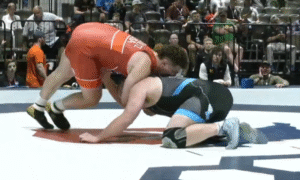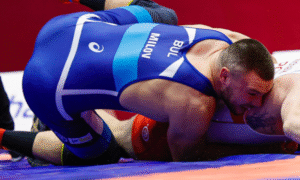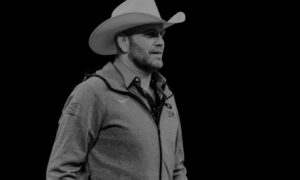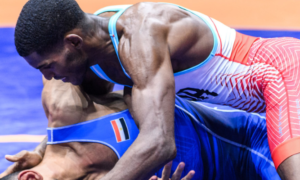Referring to an athlete who has appeared on two U23 World Teams and in a Senior National final as “underrated” might sound odd, but that’s the boat in which Jesse Porter (77 kg, NYAC/NTS) seems to be paddling these days. On one hand, it makes sense. 77 kilograms in the US is overcrowded at the moment. A long list of recent World and National Team members have converged on the weight category in advance of the Olympic Year, resulting in a handful of mainstay athletes having been relegated to the shadows. On the other, it is actually a bit perplexing given Porter’s competitive fingerprint.
Ever since Porter began toiling away on the domestic circuit roundabout four years ago, plenty have caught glimpses of his unique skill-set. Sure, he can throw. And often, he does. But it is Porter’s unorthodox style that truly sets him apart.
Most Greco wrestlers are uniform in their preambling. The whistle blows, contact is made, some wrists are grabbed, and other familiar machinations of the physical chess match commence. Not with Porter. He dances to a different tune, and in the process of developing his style, has repurposed hand-fighting into a whole new art form.
First comes the pawing and prodding from the ties responsible for enveloping an almost eerie tone. It’s all a setup. Kind of like a horror movie when flat notes from piano keys dwindle in tempo. Viewers know something big, something startling is about to happen. The filter on the camera lens for the shot was dimmed by the director for the sole purpose of feeding into the angst. So, it builds. Eighth notes slowly transition into quarter notes; the camera pans out and then zooms in; and now the anticipation is so great that by the time we arrive to the one moment we all paid to see, we are vibrating with such a high degree of sensitivity that we’re grateful to have been jolted so completely. The exhalation afterwards doesn’t last long enough to adequately express our relief.
The dynamism for which Porter has become known is best complemented by two functional attributes (aka, the things that help wrestlers score points): clean throw and lift technique — and head-turning counter attacks. On a dime, Porter can, and frequently has, taken over actions of his opponents and walked away with the scores. It is one of his most pronounced strengths, and why he is seen as a more-than legitimate contender to secure a spot in the US Olympic Trials next spring.
But — at the ’19 Bill Farrell Memorial this past November in New York, Porter squeezed into a 77-kilogram bracket that was overrun with high-profile competitors, all of whom were especially motivated given the tournament’s Trials implications. Compounding matters further for he and and his stateside colleagues was the addition of a handful of foreigners. Despite its status as a Trials qualifier, the Farrell still operated as an international event with the highest-placing US athlete in each weight receiving Trials bids. Just one more example of the head-scratching selection procedures with which US wrestlers were forced to contend this season.
There were no easy routes. Not really. Only a few bouts contested early on in the bracket included much in the way of competitive disparity. This was to be expected. What wasn’t? A US athlete being forced to overcome a World and Olympic champ just to remain alive entering the quarterfinal.
PORTER VS. STEFANEK — 2019 BILL FARRELL MEMORIAL RD. OF 16
Porter drew Davor Stefanek in the round-of-16, the Serbian superstar who walked away from Rio ’16 with gold at 66 kilos (thanks in large part to horrendous officiating, but let’s keep going — Ed.). Don’t be fooled by the jump in weight class. Throughout a career that is about to reach its 16th season, Stefanek has fluctuated in weight enough times to where his climb to 77 in New York was not the lead story. The fact that a Serbian delegation was even present offered a nice wrinkle. But Stefanek’s weight was shrugged off as nothing more than the whims of an elite, World-class competitor who didn’t feel like depleting for an early-season tournament — in America of all places, where by virtue of simply showing up he would far and away be considered the bracket favorite regardless of weight category.
That narrative, solid in its construction, lasted about two whole minutes.
Porter’s deliberate entries into hand-fights and full-on pummeling are oft scrutinized because he does not dig from a more classical hips-in position. He likes to scan for opportunities with just a little distance involved. Officials tend to not fall in love with this approach, which keeps him on thin ice until attempts are made. Stefanek did not allow for any good looks early in the first, therefore it was not a surprise to see passivity go the Serbian’s way.
The resulting sequence from par terre did not win the match for Porter but it definitely provided a quick education for Stefanek, who still required a most basic lesson: there are some guys you front headlock, and some guys you don’t.
A common adage in Greco, or wrestling in general, is “the best time to score is after you just scored.” Porter knows this well. As soon as he finished executing his four-point counter score, he used his one and only par terre chance to pick up two more from a correct throw.
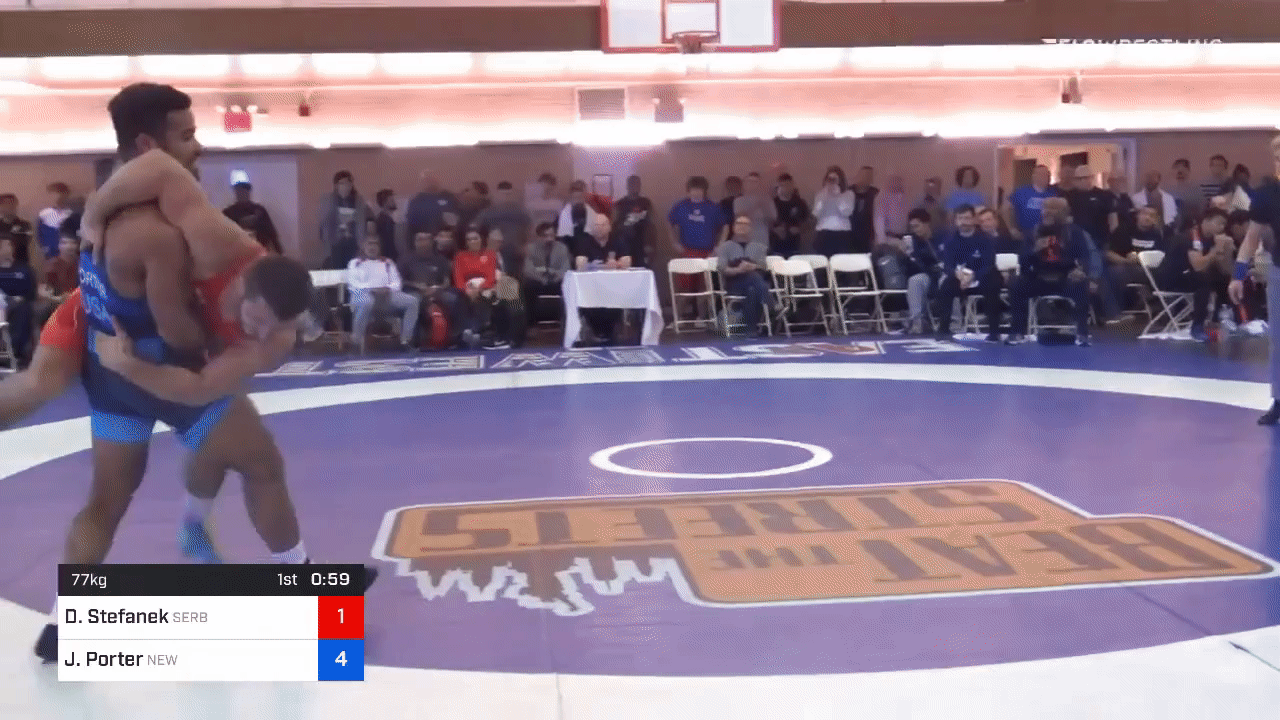
Porter (blue) came close to a four-pointer with this lift against Davor Stefanek last November in New York. Stefanek knew to keep his far arm wrapped over Porter’s back, which allowed him to have a post once the throw was executed. Nevertheless, the two points Porter received represented the penultimate scoring yield, as the NMU wrestler ended the match altogether shortly after the proceeding restart. (Image: FLOWrestling)
Two actions down, one to go.
Now, Stefanek was not out of it. A five-point deficit can be erased in an eyeblink, plus there were nearly four minutes of wrestling still available. This also wasn’t the case of a “broken” athlete. Stefanek — for all of his quirks, complaints, and pleas to officials — is very much an ice cold competitor who never quits, and his four World-level medals speak to both his talent and resilience. But he made a questionable decision upon the restart. He had immediately broke for his chopping headlock, which would have been just fine if he bailed and switched off to another tie or position as soon as it was apparent that Porter wasn’t going anywhere.
Instead, he stubbornly retained his grasp, trying with all of his muster to corkscrew Porter. He then became the recipient of the most booming counter score achieved by a US athlete against a foreigner through all of last year.
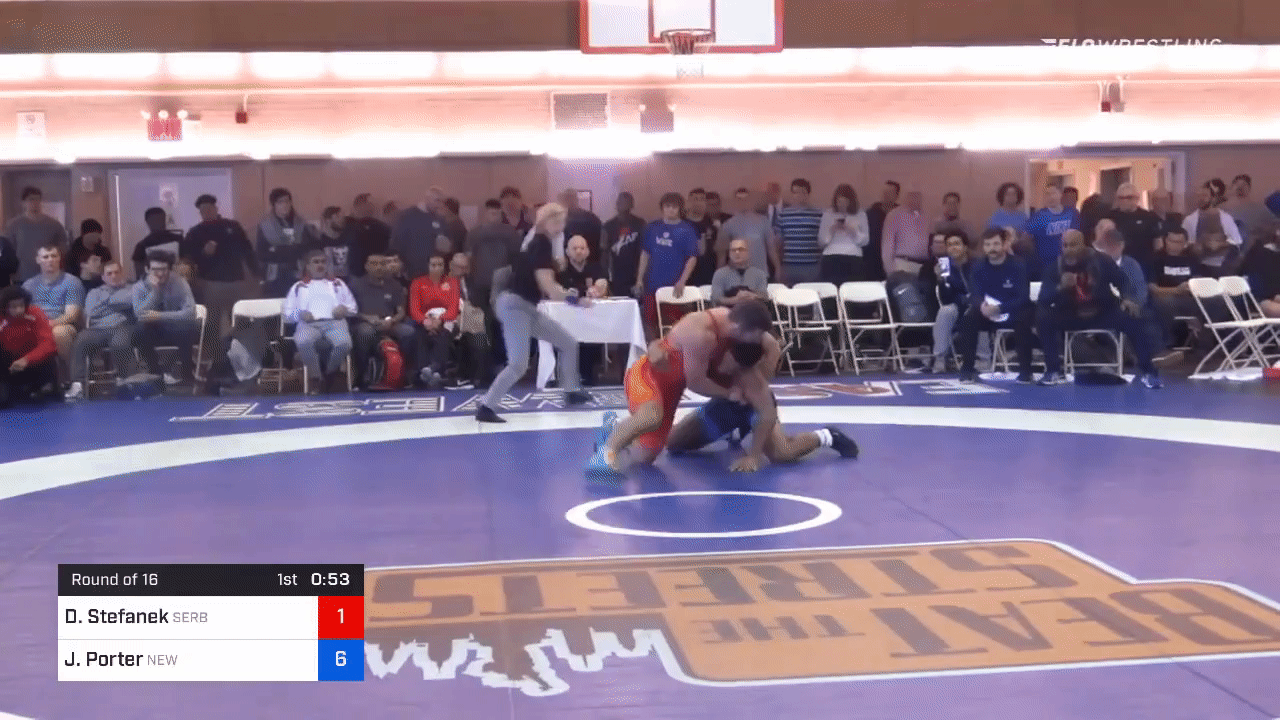
There is a time to leave well-enough alone: Stefanek’s (red) insistence on holding onto this headlock attempt helped pave the way for Porter to waterfall into a match-ending throw. The name attached to this 11-1 win via tech for Porter currently stands as the biggest of his career. The last US athlete to defeat a prior Olympic champ was G’Angelo Hancock’s (97 kg), whose quick destruction of multi-time World/’16 Olympic gold Artur Aleksanyan (ARM) in August of ’18 managed to propel him into the national spotlight. (Image: FLOWrestling).
After Stefanek was planted and the score was confirmed, he challenged the call. Perhaps part of him wondered if there was even a chance the score could be knocked down to two, but it was really just a formality. Nothing much more to lose in situations like that. 11-1 doesn’t look a whole lot worse than 10-1, does it?
The New York Athletic Club’s gymnasium was not designed to host a large number of spectators, but those who were in attendance (and paying attention) reacted as you might suspect. They knew what they had just witnessed. The only downside to this match was on the individual level for Porter. Two bouts later, he fell to now-former Northern Michigan teammate Spencer Woods and wound up finishing fourth. Stefanek, he was done-zo following this bout since wrestle-backs were not contested for wrestlers who lost prior to the quarterfinals.
But taken on its own merit and at face value, this was a glittering showcase of why Porter’s customized approach to combat and penchant for counter scores can be effective against a wide range of opponents — and proof that American Greco athletes don’t have to do everything the same way everyone else around the world does to become successful.
Listen to “5PM37: The wildman Sammy Jones” on Spreaker.
SUBSCRIBE TO THE FIVE POINT MOVE PODCAST
iTunes | Stitcher | Spreaker | Google Play Music









